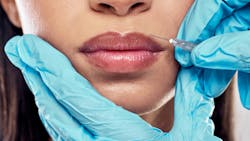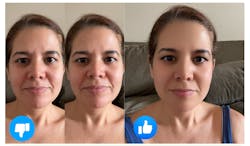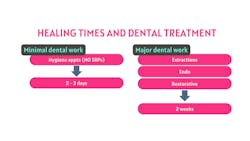Lip fillers gone wrong: A pathology-centered perspective for dental hygienists
What you'll learn in this article
-
How to recognize common lip filler complications—like nodules, infections, and allergic reactions—during dental visits
-
Why cosmetic concerns may signal deeper psychological issues, and how to approach patients with empathy
-
Key clinical clues that differentiate filler-related pathology from other oral conditions
-
When to delay dental treatment after filler procedures to reduce risk of complications
In today’s image-driven culture, the pursuit of esthetic enhancement has become not only more normalized but also more medically complex. Lip fillers—once considered a niche cosmetic luxury—are now part of a booming, billion-dollar industry. Yet, as popularity skyrockets, so do complications. As dental hygienists, we are increasingly in the front row of this evolving reality, where oral and perioral tissues are frequently manipulated by elective procedures that can lead to unintended pathological consequences.1
Social media, body image, dysmorphia, and the lip fixation loop
Emerging research highlights a strong correlation between time spent on social media and increased body dissatisfaction, particularly due to the facial distortions introduced by selfies and filtered imagery.2 Continuous exposure to digitally enhanced appearances can gradually shift individuals’ perceptions of what is “normal” or “natural,” a psychological phenomenon referred to as perceptual drift.3 This effect is especially relevant in the context of lip augmentation, where the pursuit of fuller lips is often shaped more by online beauty ideals than by clinical or anatomical considerations.
Although many patients seek lip fillers to restore age-related volume loss, improve symmetry, or enhance facial harmony, these desires can sometimes conceal deeper struggles with self-image, low self-esteem, or an overwhelming need to conform to social standards of attractiveness.4 Several studies have linked such esthetic motivations to body dysmorphic disorder (BDD), a condition marked by persistent and distressing preoccupations with perceived physical flaws.5
Even though dental hygienists are not mental health professionals, we are well positioned as educators and advocates. When a patient demonstrates a pattern of repeated cosmetic procedures or shows disproportionate concern about subtle or unnoticeable imperfections, this may signal the need for a gentle, empathetic conversation—and, when appropriate, a thoughtful referral to a mental health specialist.6 Our role is to start with curiosity, not judgment. A simple “Tell me about any recent changes to your lips or cheeks; any treatments done?” can open a valuable conversation in supporting patients’ overall well-being. It extends beyond oral health and includes recognizing when esthetic concerns may reflect deeper emotional vulnerabilities.
Signs to watch for:
- Obsessive concern over lip shape despite recent treatment
- Repeated cosmetic enhancements with minimal satisfaction
- Anxious behavior during intraoral or extraoral examination
A quick historical glance: Why this matters
Hyaluronic acid (HA) fillers, with their reversibility, have been marketed as safe, noninvasive, and nearly risk free.7 But “nearly” is the operative word. While filler materials have improved significantly since the catastrophic days of paraffin injections in the early 20th century, adverse reactions still occur, and dental hygienists are often the first to spot them.
In the late 1800s, early lip enhancement efforts used patient-derived tissue. By the 1920s, paraffin and later silicone became the fillers of choice. These materials led to disfigurements, paraffinomas, and granulomatous inflammation that haunted patients for decades. Even today, remnants of these early experiments may still be observed in the medical history or on the lips of older adults.8
This is why understanding the legacy of these materials isn’t just academic trivia; it will sharpen our diagnostic radar.
Elevating our scope through pathology
One of the biggest misconceptions is that HA fillers are completely benign. While HA is naturally occurring, its cross-linked injectable form behaves differently in tissue, triggering immune responses in sensitized individuals, acting as a scaffold for bacterial biofilm formation, and even being able to create persistent inflammation.9
In today’s climate, where dental hygienists often talk about expanding their clinical scope, it is imperative to understand that true growth also happens when we deepen our observational skills and elevate our diagnostic contributions. As cosmetic procedures migrate closer to the oral cavity, so must our awareness of their implications.
Imagine this scenario: a patient presents with a persistent, firm lump on the upper lip. It’s been there for months. They say it developed “out of nowhere,” deny trauma, and say they haven’t seen their injector in over a year. You note mild asymmetry, no tenderness, and intact mucosa. You suspect a late-onset granuloma from a prior HA filler. You document thoroughly, inform the supervising dentist, and refer to an oral medicine specialist. This way of doing things is oral pathology in action.
Common filler-related pathologies: What to look for
We are trained to detect subtle intraoral changes, white patches, mucosal ulcerations, and unexplained nodules. But when pathology appears extraorally, particularly on or around the lips, it’s easy to assume it lies outside our scope, but this is not the case. Lip fillers can cause a broad spectrum of complications, ranging from vascular emergencies to granulomatous inflammation and chronic infections. Patients may not disclose cosmetic procedures during routine medical history updates, which makes our role in observing and documenting esthetic changes even more critical.
Delayed-onset nodules are often the result of a delayed immune response or biofilm formation.10 They may appear weeks, months, or even years after the procedure.
- Clinical clues: well-circumscribed, firm submucosal nodules, often painless but persistent
- Differential diagnoses: mucoceles, lipomas, fibromas
- What to do: Recommend medical referral. Histopathological analysis may be needed to rule out foreign body granulomas.
Allergic reactions to fillers: Although HA fillers are generally considered safe and carry a lower risk of allergic reactions compared to older materials such as bovine collagen or
silicone-based products, hypersensitivity responses can still occur.11
- Clinical clues: localized itching, erythema, or swelling at the injection site. In some cases, patients may develop hives or a rash that extends beyond the area treated. More severe reactions, though rare, can involve facial edema, difficulty breathing, and circulatory compromise—hallmarks of anaphylaxis requiring emergency care.
- What to do: Management depends on the severity of the reaction. Mild cases may resolve with oral antihistamines and close observation. However, any signs of systemic involvement or respiratory distress should be treated as a medical emergency, necessitating prompt administration of epinephrine and supportive measures such as oxygen and IV fluids.
Infectious complications include bacterial, viral (herpetic), and fungal infections that can occur due to nonsterile injection technique or compromised tissue integrity.
- Clinical clues: erythema, pain, warmth, purulence, recurrent herpes outbreaks near injection sites
- What to do: Document, photograph, and refer. Be aware that these infections can disguise as aphthous ulcers or angular cheilitis.
Vascular occlusion is a medical emergency in which filler material blocks a labial artery, leading to ischemia and tissue necrosis.12
- Clinical clues: blanching, severe pain, rapid swelling, duskiness, and eventual ulceration or scabbing
- What to do: This requires immediate referral. Early intervention can save the affected tissue, and any delay in the treatment can cause irreversible necrosis and scarring.
Filler migration and tissue distortion may happen over time and occurs when fillers shift away from the injection site due to muscle movement, overfilling, or improper injection technique.13
- Clinical clues: asymmetry, unnatural lip contouring, lumps near philtrum, nasolabial folds, or chin
- Differential diagnosis: salivary gland lesions, cysts, and trauma-induced swelling
- What to do: Review the patient history and esthetic timeline. Gentle conversation may prompt the patient to disclose their treatment history.
Foreign body granulomas: These inflammatory reactions form in response to filler particles, particularly older or permanent materials like silicone or PMMA.14
- Clinical clues: chronic, firm nodules that resist massage and recur after treatment
- Histology: multinucleated giant cells surrounding nondegradable material
- What to do: Refer for biopsy and confirm pathology. Inflammatory nodules may require intralesional steroids or excision.
Timing matters
Performing dental procedures too soon after lip filler injections can increase the risk of complications (figure 1). Fresh injection sites are more vulnerable to bacterial contamination, and allowing adequate time for healing helps reduce the likelihood of posttreatment infections. Additionally, soft tissue trauma is a concern; swelling and bruising are common following filler placement, and further manipulation during dental care may intensify discomfort or inadvertently cause filler displacement. Anesthetic effectiveness can also be compromised; swollen tissues may hinder the diffusion of local anesthesia, making pain management more challenging.
As the pursuit of esthetic enhancement becomes increasingly normalized, dental hygienists find themselves at a vital intersection of health, beauty, and psychology. Our role must now evolve to meet the demands of this new reality, and while recognizing their impact, guide our patients with empathy and uphold a standard of care that extends beyond the oral cavity. By deepening our understanding of filler-related complications and the motivations behind them, we empower ourselves to contribute meaningfully to early detection, informed decision-making, and the promotion of a healthier, more authentic self-image.
Editor's note: This article in the July 2025 print edition of RDH magazine. Dental hygienists in North America are eligible for a complimentary print subscription. Sign up here.
References
- Luthra A. Shaping lips with fillers. J Cutan Aesthet Surg. 2015;8(3):139-142. doi:10.4103/0974-2077.167269
- Ward B, Paskhover B. The influence of popular online beauty content creators on lip fillers. Aesthet Surg J. 2019;39(10):NP437-NP438. doi:10.1093/asj/sjz183
- Ibn Auf AAA, Alblowi YH, Alkhaldi RO, et al. Social comparison and body image in teenage users of the TikTok app. Cureus. 2023;15(11):e48227. doi:10.7759/cureus.48227
- Love M, Saunders C, Harris S, Moon Z, Veale D. Redefining beauty: a qualitative study exploring adult women’s motivations for lip filler resulting in anatomical distortion. Aesthet Surg J. 2023;43(8):907-916. doi:10.1093/asj/sjad050
- Alharbi A, Alkhathami A, Farooqi FA, et al. The prevalence of body dysmorphic disorder and its associated risk factors among dental patients: why are my patients not satisfied? Cureus. 2023;15(11):e49739. doi:10.7759/cureus.49739
- Arab K, Barasain O, Altaweel A, et al. Influence of social media on the decision to undergo a cosmetic procedure. Plast Reconstr Surg Glob Open. 2019;7(8):e2333. doi:10.1097/GOX.0000000000002333
- Nikolis A, Bertucci V, Solish N, Lane V, Nogueira A. An objective, quantitative assessment of flexible hyaluronic acid fillers in lip and perioral enhancement. Dermatol Surg. 2021;47(5):e168-e173. doi:10.1097/DSS.0000000000002917
- Glicenstein J. Les premiers “fillers”, vaseline et paraffine. Du miracle à la catastrophe [The first “fillers”, vaseline and paraffin. From miracle to disaster]. Annales de Chirurgie Plastique Esthétique. 2007;52(2):157-161. doi:10.1016/j.anplas.2006.05.003
- Diwan Z, Trikha S, Etemad-Shahidi S, Parrish N, Rennie C. Evaluation of current literature on complications secondary to lip augmentation following dermal filler injection. J Clin Aesthet Dermatol. 2023;16(7):26-33.
- Modarressi A, Nizet C, Lombardi T. Granulomas and nongranulomatous nodules after filler injection: different complications require different treatments. J Plast Reconstr Aesthet Surg. 2020;73(11):2010-2015. doi:10.1016/j.bjps.2020.08.012
- Bulam H, Sezgin B, Tuncer S, Findikcioglu K, Cenetoglu S. A severe acute hypersensitivity reaction after a hyaluronic acid with lidocaine filler injection to the lip. Arch Plast Surg. 2015;42(2):245-247. doi:10.5999/aps.2015.42.2.245
- King M, Walker L, Convery C, Davies E. Management of a vascular occlusion associated with cosmetic injections. J Clin Aesthet Dermatol. 2020;13(1):E53-E58.
- Abtahi-Naeini B, Faghihi G, Shahmoradi Z, Saffaei A. Filler migration and extensive lesions after lip augmentation: adverse effects of polydimethylsiloxane filler. J Cosmet Dermatol. 2018;17(6):996-999. doi:10.1111/jocd.12476
- Trinh LN, McGuigan KC, Gupta A. Delayed granulomas as a complication secondary to lip augmentation with dermal fillers: a systematic review. Surg J (N Y). 2022;8(1):e69-e79. doi:10.1055/s-0042-1743524
About the Author

Andreina Sucre, MSc, RDH
Andreina Sucre, MSc, RDH, is an international dentist, oral pathology, and oral surgery specialist practicing dental hygiene in Miami, Florida. A passionate advocate for early pathological diagnosis, she empowers colleagues through lectures focused on oral pathologies. Andreina spoke on this topic at the 2024 ADHA Annual Conference, 2023 RDH Under One Roof, and she writes about oral pathology for RDH magazine. Committed to community outreach, she educates non-native English-speaking children on oral health and actively volunteers in dental initiatives.


